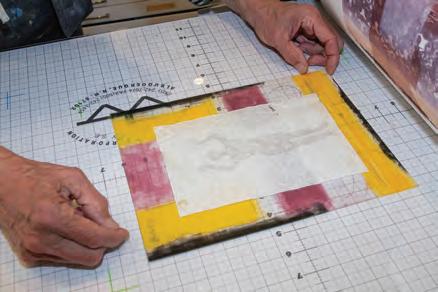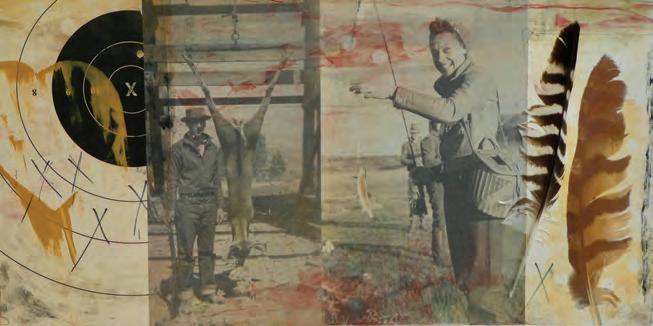
9 minute read
Pressing Matters of the Heart
Fallbrook monotype printmaker puts it all on the plate.
by Sandra Shrader
Advertisement
Make Art!
fallbrook school of the arts
See Art!
fallbrook art center
103 S Main | 760.728.1414 fallbrookartcenter.org
N. Dixon Fish knows it takes a little luck to make a favorable first impression.
Yet, as the master printmaker and Fallbrook School of the Arts instructor, 79, teaches about creating monotype prints, printmaking is a fairly straight-forward process from start to finish; beginning with the creation and inking of a flat plate and ending with “pulling the print” after the print machine’s rollers have done their work.
But there are no guarantees that a print will turn out just as expected. And that, Fish said, is the mysteriously exciting part of printmaking, an art form upon which he has largely focused since 2001.
“There are ‘risks’ or variables in each stage of the process, whether or not one is using plates that are engraved or etched, woodblock or linocut, or solarplates which I like to use at present,” the printmaker said, adding that the majority of his prints are monotype.
“The amount of ink on the plate, how that ink is manipulated or removed from the plate, the kind of ink that is used, the type of paper, how damp should the paper be—all those factors can influence the print image,” he explained.
“And more often than not, the end result will convey a different impression, maybe one that turns out to be more meaningful than what was intended.”
Born near the base of California’s Eastern Sierra range followed by a childhood spent at desert cattle ranches in Arizona, Fish is naturally inspired by mountain majesty, wide open spaces of sky and land, and the splendid natural world apart from that of human busyness.
“Ancestors” by Dixon Fish.

Courtesy photo Monotype printmaker artist Dixon Fish inside his Fallbrook home studio.


Shane Gibson photo
He earned a Master of Fine Arts at Arizona State University in 1967, before teaching studio art, art history and photography for more than 30 years at the high school and college levels in San Diego and Arizona.
And if that wasn’t enough creative fun, Fish took up theater set design and painting for professional regional theaters in San Diego and North County San Diego, including nearby Vista’s Moonlight Amphitheater and Avo Theater.
It was printmaking, however, which became his longest and strongest passion, and in 1968 he began winning the first of numerous awards, nationally and regionally.
Flowing around and through Fish’s pleasure in the “wait-andsee” process of printmaking are the memories of the landscapes of his childhood along with his own quietly contemplative meditations about life and death, about trees and nature, about his father and mother and even about his own heart.
His prints additionally reflect another influence, he said: one which stems from an art movement which began in the Netherlands in the 16th and 17th centuries. Known as “Vanitas” art, the inclusion of objects as symbols in still life paintings were used to show the transient and ephemeral nature of life. Today Vanitas art is not as book-and-skull somber as it was, and the mood has lightened with objects, again as symbols, often tumbled together.
This practice resonates deeply with Fish, as shown in particular with his current series of prints, because of the condition of his own heart.
“The newest series of my work is being created in reaction to a diagnosis that I have a genetically deformed heart,” said the printmaker, whose recent print series include the faint images of his mother and of his father, his grandfather’s tombstone, an MRI of Fish’s chest, keys, feathers, and strawberries which symbolize hearts.
“Therefore, my family history is reflected in some of my art,” Fish continued in his artist’s statement.
“I have to question how many generations of ‘bad’ hearts there have been. And I am also exploring the relationship of ‘good’ hearts and ‘bad’ hearts. I am astounded by the number of ideas that this series has generated—there’s much more to do.”
Fish’s prints are generally created as mixed media, meaning that after the print is made, other elements via acrylic paint, relief stamps and colored pencils are added. He also uses a process called “Chine-collé” in which thin paper such as rice paper or origami paper is pasted or glued to the print for more visual interest, and then run through the printing press.
The process of creating each of his visually dreamlike mixed media prints is a very personal undertaking for Fish, one that can
AVOCADO ANIMAL HOSPITAL
Your Local Fallbrook Veterinarian Dr. Najdat Nissan
Licensed & Experienced
Our entire team is committed to keeping your companion(s) healthy all year round.
Avocado Animal Hospital stays on top of the latest advances in veterinary education and technology. Above all, we remember that all of our patients need to be treated with loving care in every checkup, overnight stay, procedure, vaccination, or surgery. Call today to schedule an appointment! Dentistry Dermatology Ear Crops Emergency Medicine In house laboratory Internal Medicine Preventative Medicine Surgery Digital Imagery Ultrasound
760-728-5771 OPEN M-F 9-5 & Sat 9-12 1111 E. Mission Road, Fallbrook avocadoanimalhospital.com

Printmaker Dixon Fish uses only soy and water based inks for his prints rather than oil based inks which contain harmful chemicals. Printmaker Dixon Fish reveals a finished print from the press.

“A Lifetime Ago” by Dixon Fish.
Courtesy photo Dixon Fish holds a clear sheet with ink that will be fed through the press and applied to absorbent paper. Shane Gibson photos


“Cowboys Come ‘n Go” by Dixon Fish.
Courtesy photo
take days to formulate, he said.
But Fish is no recluse who just spends solitary days at the etching printer in his home studio.
The printmaker is very much part of the art communities in Fallbrook and in San Diego and North San Diego counties. He is also a juried member of the Los Angeles Society of Printmakers.
Fish’s wife Connie, whom he called his “organized other half,” is involved with the Fallbrook Arts Inc.’s board of directors, and Fish has volunteered for several years to create window displays for the Fallbrook Art Center’s shows and exhibits.
As the longtime director of printmaking at the Fallbrook School of the Arts, Fish teaches beginning and intermediate learners how to create monotypes which are fast and easy to do.
Monototypes, the process of which is said to have been first invented in the mid-1640s, are usually created today by applying printing ink – Fish only uses soy or water-based inks – to a nonporous surface like Plexiglass. The ink is removed from the surface with a rag, Q-tips or brushes to make an image or design. The plate is then run through a press with paper on top of it to create a print.
If enough ink is left on the plate, the process is repeated, but will likely end up with a “ghostly” effect which is often a desired result too.
“As I tell the students, no two monotypes will ever be alike,” Fish said. ”They are unique, can be fast and fun to do, and photos, sketches and thin papers can be added to a them. You never know how the print is going to turn out until it is pulled off of the press.”
And that mystery is still what keeps Fish pressing forward with his passion for printmaking.
I can help you sell your home for MORE MONEY!
Put My Vast Experience to Work for You!

• Local Realtor - Lives And Works In Fallbrook • 25+ Years As A Real Estate Attorney (J.D.) • Masters Of Law In Taxation (L.L.M.) • Senior Real Estate Specialist (SRES) Designation • Short Sale - Pre-Foreclosure Specialist (Sfr) • 1031 Tax Free Exchange Facilitator
• Bringing Qualified Buyers Ready
To Purchase Now
HENRY PORTNER
JD, LLM, SRES, SFR Call 760-663-0000
Dixon Fish’s prints are on public display at the “Historic Wall of Prints” installation at the Fallbrook Public Library, 124 S. Mission Road. To watch the printmaker demonstrate how to create a monotype, visitwww.youtube. com/watch?v=l1gi9Xa-7ns.
Each Offi ce Is Independently Owned and Operated


COLDWELL BANKER VILLAGE PROPERTIES
Fallbrook’s Top Producing Real Estate Company
Chris Hasvold is the owner/broker of Fallbrook’s premier, full-service real estate company, Coldwell Banker Village Properties. Chris and Lisa Hasvold are the sole owners of the company and work full time to meet their customer’s needs. Chris serves as the managing broker and has been in the real estate business for 40 years. Lisa is the marketing director and operates their in-house print shop, producing property fl yers, brochures, direct mail pieces and other marketing material for the company’s agents.
Coldwell Banker Village Properties has 30 agents who are the top in their industry and on average have been with the company for 16 years. As managing broker, Hasvold’s att itude is that it’s his responsibility to provide his agents with the tools and resources they need to be successful. “I believe we have that and we off er the best range of services and support for our agents. We have the best agents around and I am here to serve them. As a premier full-service real estate company we can take care of everything. We off er an in-house lender along with local escrow and title company affi liations. Our team of agents specialize in homes, luxury properties, land, investment property and development. We truly understand all the nuances of selling real estate in an unincorporated county. It’s a diff erent animal. We deal with septic systems, property corners, private roads and county restrictions that agents and brokers from cities don’t understand. This company’s reach is as broad as any national fi rm. Through the Coldwell Banker marketing program, we can expose properties more eff ectively than our competitors. Combine that with our local expertise and we off er the best of both worlds.”
Fallbrook’s top producing real estate company, Coldwell Banker Village Properties is conveniently located in River Village, 5256 So. Mission Rd, Suite 310, Bonsall at the intersection of Hwy 76 and Mission Rd. Easy access for customers from the coast as well as the inland areas.










